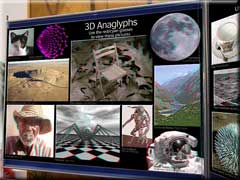|
|
This exhibit shows you how we can make and view 3D pictures.
We can see in 3D because our two eyes can see two different things. When we look at objects, each eye sees something slightly different, because of the distance between the two eyes. This is how we see in 3D.
To make 3D images, we have to see two different things with each eye. To do this, we normally wear special glasses. But recent technology has come out that allows us to see 3D images without glasses.
3D glasses have different lenses over each eye. These lenses filter out a different part of the image you see so that you see different images with each eye.
The 3D Anaglyphs exhibit uses red and green lenses. The pictures used consisted of two pictures on top of each other, one printed in red and one in green. The eye with the green lens sees the red image as black, but cannot see the green image as it is no different to its surroundings, and vice versa. The pictures are always photographed or drawn to be roughly an eye distance apart (about 6-8cm). The result is that you see the pictures in 3D.

Other 3D vision techniques
3D films cannot simply be shown in red and green: they need to be able to display all colours. A different technique is needed to show such films, and one which – as much as is possible – doesn't interfere with your colour vision. In the most common system today (~2010), the 3D glasses you get at cinemas have polarised lenses.
Light is a wave and can be drawn as a zig-zag with curved corners. In normal light, the angle of the wave can be in any direction. Polarised lenses only allow through light waves that are in one direction.
The two lenses of 3D glasses let through different directions of light. This means that two different images can be projected onto the screen, in the two different directions of light. Each eye is only seeing one of the two images, and you see the pictures in 3D.
Devices such as the Nintendo 3DS allow you to see in 3D without glasses. These show different images to each eye. This can be done by making the pixels curved and putting something different on each side, or putting small barriers over the pixels that only allow your eye to see one of two things. Both of these result in you seeing a different thing with each eye.
|
Questions
|
| 1 |
What do we normally need to see 3D images? |
| 2 |
How did the lenses in the 3D Anaglyphs exhibit work? |
| 3 |
How far apart should pictures be taken to be used as 3D images? |
| 4 |
What kind of light do 3D films use? |
| 5 |
What two methods can we use to show two different images to each eye on a single screen, without glasses? |
| 6 |
In what other SCI-FUN exhibit did you look at the different views from our two eyes? |
|
Activities
|
| 1 |
Use the lenses from 3D glasses from the cinema to explore polarised light. Either take apart one pair, or use the opposite lenses from two different pairs. Place one lens on top of the other and point it at the light. Keep one lens still and rotate the other. Sometimes they will be completely opaque, but at other times you can see through them. |
| 2 |
Go and see a 3D movie at the cinema or have a look at a 3D TV (one that needs glasses) in a shop. During some 3D adverts or trailers take off your 3D glasses. What can you see on the screen? |
|
Useful links
|
| 1 |
|
|
|
| 2 |
Go and see a 3D movie at the cinema or have a look at a 3D TV (one that needs glasses) in a shop. During some 3D adverts or trailers take off your 3D glasses. What can you see on the screen? |
|
|
|
Exhibit graphics
|
|
The following images show you the SCI-FUN exhbit itself, as well as any associated graphics and information. For each of these, click on the picture or the text underneath to see a larger version.
|


Click on the image thumbnails below to download JPEGs with the 3D anaglyphs on display in the Roadshow. (The file accreditations are listed on the posters.)
|
|

